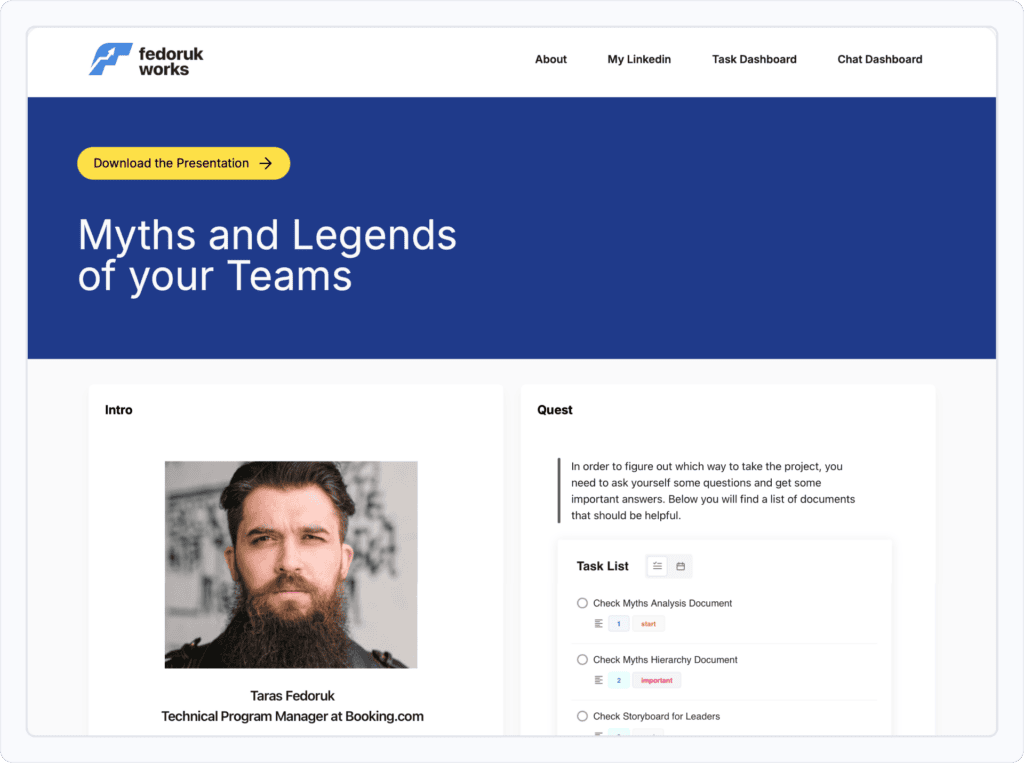
How Myths Can Shape Organizational Culture and Drive Your Business
- October 24, 2024
- 6 Min read
What if we told you that myths and legends are affecting your business now? Corporate myths are not just stories. They can unite teams, inspire in difficult times, and of course drive success. But what makes them so influential? What is the secret to the power of myths?
During our recent webinar with Taras Fedoruk from Booking.com, we took an insightful journey into the myths that form modern business culture. In this article, we’ll look at how stories embedded in organizations influence decisions, foster connections, and build a lasting legacy.
How Myths Shape Culture, Influence Decisions, and Impact Success
Myths play a critical role in forming how people think, work, and succeed together. We summarized for you the key points that we discussed during the webinar.
Examples of Corporate Myths and Their Impact on Productivity
Every company has its own stories. Some are about how a team refused to give up and overcame a crisis, others are about a legendary product launch. Over time, these stories become more than just memories. They motivate teams and guide their actions in the future, thus becoming collective myths. As a result, success stories create a sense of pride, enhance team spirit, and increase productivity.
Defining an Organization’s Values, Beliefs, and Behaviors
Did you know that stories also reflect a brand’s core identity? Myths communicate what a company stands for, its beliefs, and its ideas. An important thing is to show which narratives are accepted, encouraged, or celebrated. This way you influence behaviors and help employees see how their actions contribute to the bigger picture.
Fostering a Sense of Belonging
A sense of belonging is a crucial part of being in a team. If you want your team members to feel like they are a part of something bigger than themselves, you need to build emotional connections between them. And what better way to do that than through shared stories? Legends that say “This is how we do things here” give a sense of inclusion and purpose.
Challenges in Creating Organizational Myths and Legends
Even though myths can unify, creating and sustaining them can be tricky. The challenge is to create not just marketing narratives, but to craft authentic stories. They reflect the company’s true values and that’s what matters. Leaders must ensure that these stories resonate with employees and evolve as the organization grows.
Creating a Shared Purpose and Vision
Another important thing about powerful storytelling is that it brings teams together around a common vision. At this point, it’s important that everyone understands the narrative of the company’s journey, from its heroes and challenges to its ultimate goals. When your team is aware of this, it becomes easier to unite around a common goal and achieve sustainable success.
Why Myths Matter
Myths play a major role in shaping team dynamics. Why do they matter? We can summarize it in three words: unity, norms, and motivation.
- Stories create a shared sense of belonging and purpose. They help employees feel connected to one another and to the company’s mission. This builds a stronger, more cohesive team.
- Myths establish unspoken rules that guide behavior — defining “This is how we do things around here.” These stories clarify what is valued within the organization, so team members can align their actions with the company’s culture and expectations.
- Stories can serve as a powerful source of inspiration, especially during tough times. These narratives encourage employees to push forward, embrace challenges, and keep striving toward success, whether it’s a tale of resilience or a moment of breakthrough innovation.
Discover more about the power of stories!
5 Key Insights from the Webinar
Stories we tell about ourselves help build meaningful connections within teams. This narrative thread connects individuals and says “You are seen. You are valued. You are a part of a larger mission”. Thereafter, personal and team experiences evolve into collaborative legends that shape culture and create deeper bonds between members.
Know who the hero of your story is — whether it’s a specific individual, a team, or the organization. It helps clarify your identity and values. By identifying the protagonist, you can position your company’s journey in a way that will resonate with your employees. Is the hero a visionary founder, a resilient team, or a customer-driven mission? Each choice has an impact on how employees see their role and contribution.
Myths bring unity, norms, and motivation, fostering alignment across departments. These stories promote behavioral norms that guide decision-making and create a sense of belonging, aligning individual efforts toward collective goals. What is valued in your organization? Is it teamwork, innovation, or maybe resilience? Shared narratives help employees understand that. With these stories organizations or leaders promote behavioral norms that guide decision-making and align individual efforts toward collective goals.
Stories enhance collaboration by providing clarity about roles and relationships among team members. Narratives highlight how different roles fit into the organization’s overall structure and how teams depend on one another. After all, cooperation, trust, and shared effort help break down barriers and lead to success.
Companies need people who promote organizational values. They are storytellers and culture advocates who breathe life into the company’s mission. These individuals act as custodians of culture, ensuring that the organization’s core values are understood, communicated, and embraced. By telling the stories that matter, they help sustain motivation and inspire new generations of employees to carry the mission forward.
How to Discover the Myths of Your Team
It takes thoughtful observation and reflection to uncover the stories that shape your team’s culture. Let’s begin with simple steps.
Step 1: Start by interviewing team members to uncover recurring stories. You may hear recollections of challenges, anecdotes, or inspirational cases. That way you will find the moments that built the team’s identity.
Step 2: Analyze team conversations and patterns to spot common themes. Pay attention to phrases, rituals, or habits that reflect the group’s core beliefs or values.
Step 3: Identify shared experiences that arise from onboarding processes or significant achievements. They often serve as the foundation for the myths that unite the team.
Don’t forget one more important thing. Reflection and critical thinking are essential throughout this process. It helps to uncover and assess the hidden narratives that influence decision-making and team behavior. By bringing these stories to light, leaders can better understand what drives their team and use these insights to guide future efforts.
Summary
Now you know that corporate myths are more than just entertaining anecdotes. From defining values to fostering belonging, these narratives help shape behavior and influence decisions. Still, powerful myths should complement the goals and beliefs of the business.
The webinar with Taras Fedoruk emphasized the importance of storytelling in the workplace. He demonstrated how powerful narratives can unite teams, drive productivity, and inspire innovation. After all, the stories we tell are the pillars of our organization’s culture.
Found it useful? Share the article with your community
Subscribe to our blog!
Get weekly tips and insights on how to grow your business
